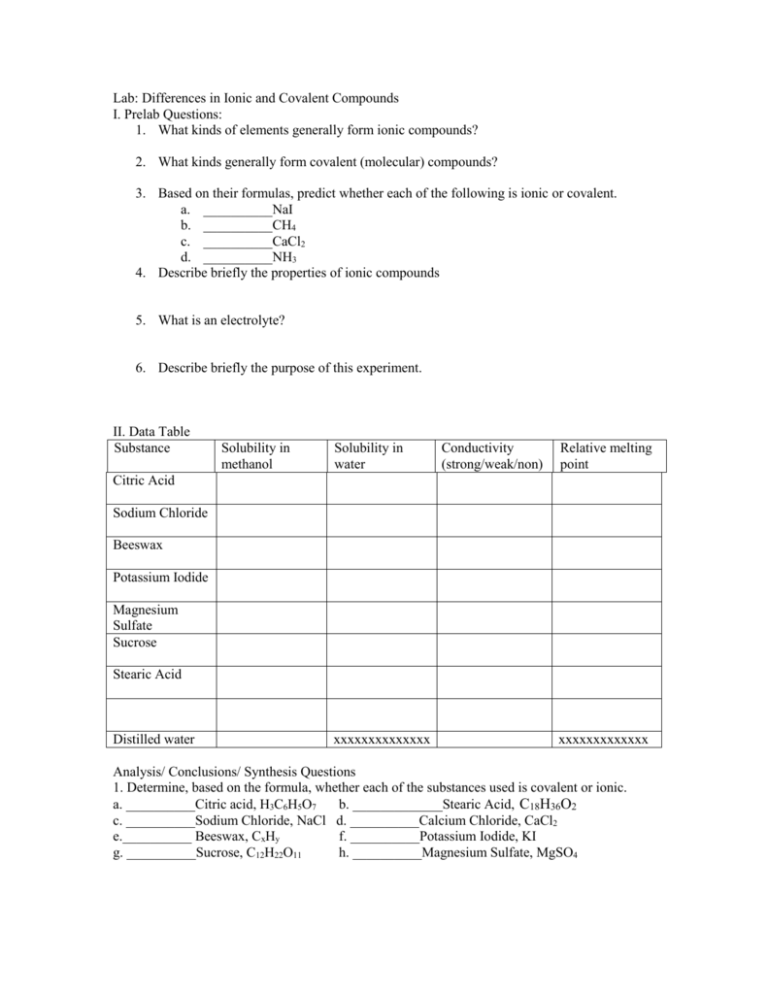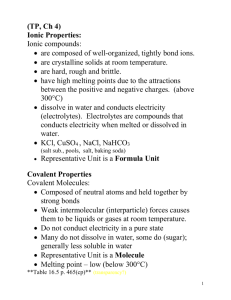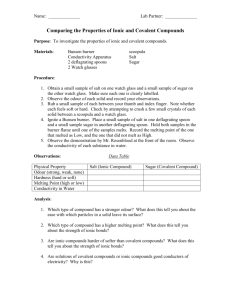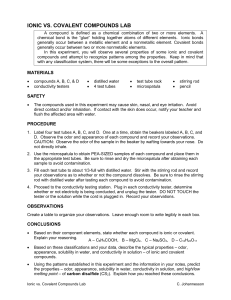Lab: Differences in Ionic and Covalent Compounds
advertisement

Lab: Differences in Ionic and Covalent Compounds I. Prelab Questions: 1. What kinds of elements generally form ionic compounds? 2. What kinds generally form covalent (molecular) compounds? 3. Based on their formulas, predict whether each of the following is ionic or covalent. a. __________NaI b. __________CH4 c. __________CaCl2 d. __________NH3 4. Describe briefly the properties of ionic compounds 5. What is an electrolyte? 6. Describe briefly the purpose of this experiment. II. Data Table Substance Solubility in methanol Solubility in water Conductivity (strong/weak/non) Relative melting point Citric Acid Sodium Chloride Beeswax Potassium Iodide Magnesium Sulfate Sucrose Stearic Acid Distilled water xxxxxxxxxxxxxx xxxxxxxxxxxxx Analysis/ Conclusions/ Synthesis Questions 1. Determine, based on the formula, whether each of the substances used is covalent or ionic. a. __________Citric acid, H3C6H5O7 b. _____________Stearic Acid, C18H36O2 c. __________Sodium Chloride, NaCl d. __________Calcium Chloride, CaCl2 e.__________ Beeswax, CxHy f. __________Potassium Iodide, KI g. __________Sucrose, C12H22O11 h. __________Magnesium Sulfate, MgSO4 2. Look carefully at your data. Do you see any patterns? In the space below, summarize the results of this experiment. 3. Predict the following, based on the patterns established in this experiment. a. Is sodium iodide soluble in water? Why/why not?______________________________ ________________________________________________________________________ b. Is the relative melting point of NaI high or low? Why/why not?___________________ ________________________________________________________________________ c. Is a solution of glucose, C6H12O6 , electrically conductive?_______________________ ________________________________________________________________________ 4. Why are the melting points of some compounds higher than others? ______________________________________________________________________________ ______________________________________________________________________________ 5. Why did you test the conductivity of distilled water before the solutions were tested?________ ______________________________________________________________________________ Lab: Differences in Ionic and Covalent Compounds Introduction: A compound is defined as a chemical combination of two or more elements. A chemical bond is the “glue” holding together atoms of different elements. Two types of bonds are ionic and covalent. Ionic bonds generally occur between a metallic atom and a nonmetallic atom. The bond results from the transfer of electrons and the attraction between the resulting ions. Covalent bonding generally occurs between two or more nonmetallic atoms. Covalent bonding involves the sharing of electrons. Properties such as melting point, boiling point, solubility, electrical conductivity, color, and odor can help you distinguish ionic from covalent compounds. As in many areas of chemistry, the distinctions are not always clear, nor do the distinctions apply to all compounds. In this experiment, you will observe several properties of some ionic and some covalent compounds and attempt to recognize patterns among the properties. The patterns you may recognize are generalizations and may not necessarily apply to all ionic and covalent compounds. Objectives: 1. Classify compounds as either primarily ionic or primarily covalent from the name and formula of the compound. 2. Observe and record some properties of several ionic and covalent compounds. 3. Recognize patterns among the properties and distinguish ionic compounds from covalent compounds. Procedure: SAFETY PRECAUTIONS: Wear safety goggles and aprons at all times. Part 1 1. Place a small sample of each solid (about the size of a grain of rice) in separate wells of a microplate. Make sure you know which is which by labeling a piece of paper and keeping it under the microplate. 2. Add methanol to the wells until they are nearly full. 3. Stir each well with a separate toothpick. 4. Observe relative solubilities and record in data table. 5. Repeat steps 1-4, only add water this time instead of methanol. 6. Keep the water solutions for part 2!! Part 2 1. Fill an extra well in the microplate with plain distilled water. Test the conductivity of the distilled water and each solution from part 1. Place the gold wires on the conductivity tester in the solution. If the red light comes on, then the substance in the solution conducts electricity and is called an electrolyte. The faster the red light blinks, the stronger the electrolyte. Rinse the wires with distilled water and blot dry with a paper towel in between each solution. 2. Record observations in data table. Part 3- PERFORM THIS STEP IN THE FUME HOOD 1. Observe relative melting temperatures of the solids. Use a spatula to place a small sample of each substance on a piece of aluminum foil. Place the foil on a hot plate. Turn the heat to medium and begin to heat the samples. Gently hold a thermometer so that the bulb just rests on the foil. Continue heating until the temperature reaches 135C. Observe each substance and record which substances have melted. Turn off the hot plate. Clean up by carefully folding up the aluminum foil (after it is cool of course!) and place it in the trash and put up materials. Be sure to clean up microplates and any other materials used and put away in the appropriate place. Wipe up lab area when finished and throw away trash.






